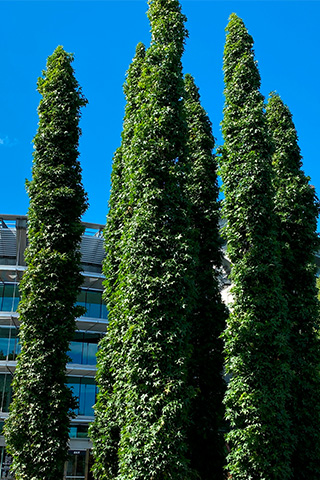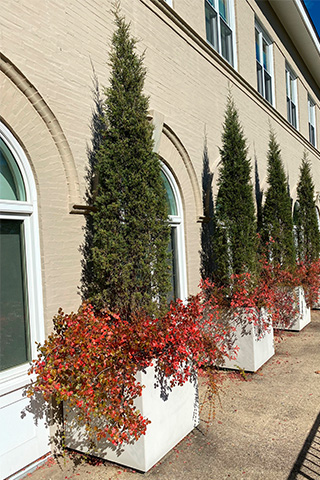5/30/2025
The Perfect Fit
Andrew Bunting

There are many places in the garden and landscape where narrow, columnar and fastigiate plants play an important role. Often, there are “tight spots” in the garden, such as in a corner, or there might be a need for two very upright trees to flank the entrance to a house. Fastigiate trees can be used between a driveway and property line where there might be little garden space for growing broader-spreading trees. There are many choices of both deciduous and evergreens to select from, which have a very narrow and tight habit.
This crowd of Slender Silhouette Liquidambar styraciflua adorn a traffic circle at Newfields in Indianapolis.
Starting With Evergreens
Growing in popularity is a selection of the Eastern red cedar, Juniperus virginiana Taylor. This upright, native, narrow conifer is a perfect addition to the garden where a vertical accent is needed. It makes a strong architectural presence in the garden, either flanking an entrance or used formally as four anchors in the corners of a garden room. At the Bondsville Park and Garden outside of Philadelphia, it’s planted informally in a meadow-like garden providing great structure and winter interest. At the Scott Arboretum of Swarthmore College, large square containers repeat across the façade of a building with a Taylor in each container. This coniferous evergreen with dark green needles is very hardy to USDA Zone 4.
Another conifer worth consideration is a selection of the Alaskan weeping cypress, Xanthocyparis nootkatensis Green Arrow (syn. Chamaecyparis nootkatensis Green Arrow). This dark green conifer has an upright habit with side branches that are pendulous at the tips. It makes a whimsical specimen in the garden. As the common name would imply, it’s very hardy to USDA Zone 4.
One of the best arborvitae selections for narrow garden spaces is Thuja occidentalis Degroot’s Spire. This compact and slow growing arborvitae reaches 15-ft. tall and 4-ft. wide at maturity. Degroot’s Spire is a good choice for a small garden where a smaller stature hedge might be needed. It can also be used as a more diminutive focal point or an architectural element to frame a view. Other arborvitaes with a comparable stature include Thuja occidentalis Sting, Full Speed A Hedge Thin Man and Full Speed A Hedge American Pillar.
Moving to Deciduous
In recent years, there have been many new selections of deciduous trees that have an upright and narrow habit. Liquidambar styraciflua Slender Silhouette is a towering fastigiate tree. Like other sweetgums, it has yellow, orange and red fall color and star-shaped leaves. It does produce spiny orb-like fruits, but since the ultimate spread of Slender Silhouette is only 5- to 6-ft. tall, the fruits essentially fall at the base of the tree, making cleanup relatively easy. At Newfields in Indianapolis in a traffic circle, several specimens create an amazing focal point. At maturity, this selection of the native sweetgum can reach 50- to 60-ft. tall.
Quercus Skinny Genes is a new hybrid oak with both the English oak, Quercus robur, and the white oak, Quercus alba, as parents. At maturity, it’s 45-ft. tall and only 10-ft. wide with a spire-like habit. The fall color is yellow and doesn’t get powdery mildew, which often plagues the English oak and hybrids.

Quercus bicolor, swamp white oak, is one of the most versatile of all the oaks. It’s used extensively across the United States as a street, shade and specimen tree, and is tolerant of both acidic and alkaline soils. It’s very urban-tough and can tolerate myriad soil conditions, including poorly drained sites. It has a wide native range from southwestern Maine west to southern Quebec and southern Ontario to northern Wisconsin and south to Missouri, and east to Kentucky, Tennessee, Virginia and New Jersey. It’s an amazing host to a wide diversity of native birds and insects. Beacon is a selection by Dr. Michael Dirr that reaches 45-ft. tall with only a spread of 15 ft., making it the perfect oak for tight and restricted garden spaces.
Juniperus virginiana Taylor in containers at Scott Arboretum at Swarthmore College in Swarthmore, Pennsylvania.
Another popular street tree or tree for urban areas is the Kentucky coffeetree, Gymnocladus dioicus. Over time, this can become a quite large tree, reaching over 80-ft. tall with a broad spread. Both Top Hat and Skinny Latte are introductions with an upright habit. The Kentucky Coffeetree has a broad native range throughout the Midwest and eastern states. This extremely tolerant tree can both withstand drought-like conditions and grow in standing water.
Acer saccharum Apollo has a fantastic golden fall color. This pyramidal selection is 30-ft. tall and 10-ft. wide. For many home gardens, the popular red maple, Acer rubrum, and sugar maple, Acer saccharum, have too big of a stature to fit into a small space garden. Apollo is perfect for the gardener with limited space who loves the characteristics of these native maples.
Some of the best of all the spring-flowering trees are the flowering cherries. There are dozens of outstanding Japanese flowering cherries. Amanogawa blooms in the spring and is covered in double, soft pink flowers that fade to white. This fastigiate form reaches over 30-ft. tall, but only with a spread of 4 to 8 ft. Like other flowering cherries, the fall color is exceptional with hues of orange and yellow.
Chionanthus retusus Tokyo Tower is a selection of the Chinese fringetree selected for its upright and narrow habit and only reaches 15-ft. tall in maturity. In the spring, it’s laden with lace-like white flowers that cover the tree. Tokyo Tower is also a tough tree and has been used successfully as a mid-sized street tree or for plantings in parks and urban settings.
Amelanchier alnifolia Standing Ovation is an upright oval-shaped small tree or large shrub. This selection of the serviceberry is very hardy to USDA Zone 2. It reaches 15-ft. tall with a spread of 4 ft. and is covered in white flowers before the leaves emerge. The fall color is red to orange and in June it’s covered in edible berries.
There are many great selections of conifers, deciduous trees and large shrubs that can be utilized in a number of landscape and garden situations where space might be limited and a narrow or fastigiate plant is needed. With thoughtful selection, these vertical plants not only solve spatial challenges, but also add year-round beauty, structure and ecological value to gardens of any size. Whether used as striking focal points or subtle space-saving solutions, columnar and fastigiate trees and shrubs add both function and flair to today’s landscapes. GP
Andrew Bunting is the Vice President of Horticulture for the Pennsylvania Horticultural Society (PHS), which uses horticulture to advance the health and well-being of the Greater Philadelphia region. To learn more about PHS, or to become a member and support greening initiatives in over 250 neighborhoods, visit PHSonline.org.